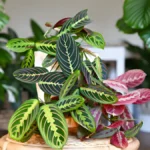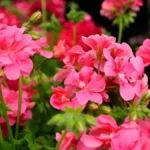Petunias are attractive flowering plants known for their bright colors and prolific blooming. These herbaceous perennials are native to South America and are usually grown annually in temperate areas. Potatoes and tomatoes are also members of the Solanaceae family, which includes petunias. Gardeners and flower aficionados often choose petunia plants because of their colorful and plentiful blossoms. We’ll explore the realm of petunias in this extensive guide.
Here’s a detailed guide on how to care for petunias and grow them:
Preparation of the soil:
- Planting petunias requires a well-draining soil mixture that has been improved with organic elements. Proper drainage is essential to prevent damp roots, which can lead to root rot. Petunias should be planted in the spring after the last frost.
Light requirements:
- Select a place with at least six hours of direct sunlight per day. Petunias need at least six hours of direct sunlight per day to grow. For best development and a profusion of blooms, place them in a spot with lots of sunlight.
Watering:
- The ideal soil moisture level for petunias is medium. When it comes to watering, they will put up with a little neglect. Although once a week is optimal, more water is needed for spreading types of petunia plants. Keep the soil’s moisture content consistent without letting it get too wet. To prevent soaking the leaves, water the base.
Temperature and Humidity:
- The ideal temperature range for petunias is 60–75°F (15–24°C). Moderate humidity is ideal for petunia plants. They tolerate heat and don’t require a lot of humidity. They don’t need a lot of humidity and can withstand heat. It will flourish between the last spring frost and the first fall frost, but it will not withstand low temperatures.

Fertilization:
- Apply a water-soluble, balanced fertilizer every two to three weeks. They’ll get all the nutrients they need for strong development and a profusion of blooms from this. Consider using slow-release fertilizers for less frequent feeding.
How to prune petunias:
- Trim back lanky stems to encourage bushier growth. If plants get excessively lanky in the middle of the season, trim it back by one-third. Remove wilted flowers regularly to ensure continual flowering. Deadheading redirects the plant’s energy from seed formation to flower production, resulting in brighter blooms.
Ordinary problems and their solutions:
- The petunia flower is not commonly associated with any significant pests or diseases. Slugs, snails, caterpillars, and aphids Control insects with insecticidal soap or neem oil. Look out for botrytis, root rot, and powdery mildew. To avoid fungus-related illnesses, make sure there is adequate air circulation and refrain from watering from above.
Seasonal care tips:
- Spring is the best season to plant petunias. During extended dry spells in the summer, water the soil frequently to keep it moist. Watering container plants frequently possibly even daily is necessary to maintain the compost’s uniform moisture content. However, be careful not to overwater; this will make the plants lanky and flowerless.
Conclusion:
In conclusion, you can have a colorful display of petunias that enhance the color and beauty of your garden all through the growing season by following this professional advice. You will be rewarded with robust plants and an abundance of lovely flowers if you give them regular care and attention to their needs.
Certainly! If you’d like to learn more, please consider following our WhatsApp Channel: Harvest Gardening
A frequently asked questions:
Q1: What is Mexican Petunias?
A1: It’s commonly called Mexican bluebell and is a highly adaptive, quickly growing perennial with purple flowers that resemble petunias rather than true petunias. They enjoy full or partial sunlight.
Q2: Are petunias poisonous to dogs?
A2: In the world of dogs, petunias are a safe choice. They are fundamentally safe for dogs, making them an ideal choice for pet-friendly landscapes.
Q3: What about Wave Petunias?
A3: These Wave Petunias are quite popular! They are an amazing variety that has been bred for large. They also have a prolific spreading growth habit.



